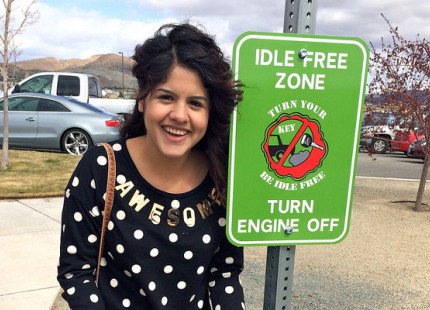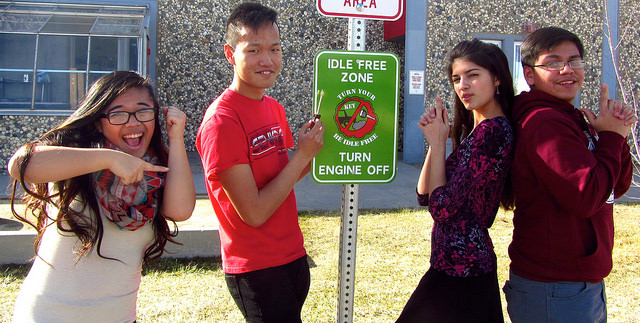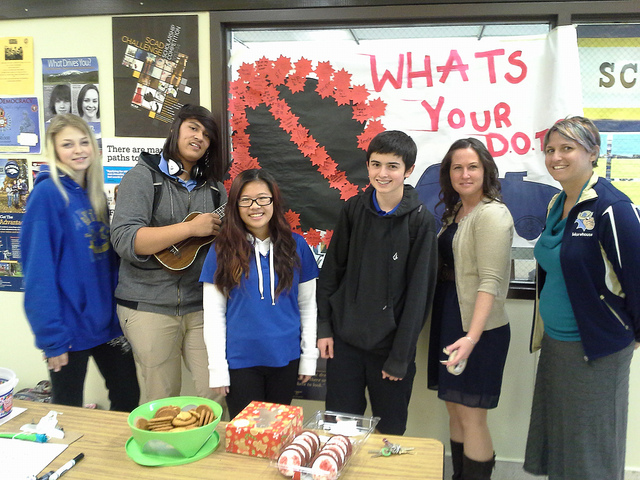Idle-Free Schools Campaign
What is Idling?
Engine idling is any time your car engine is running but you’re not moving. Think waiting outside school, at a red light or in a drive-through.
Running a car without going anywhere just doesn’t make any sense! Here are four reasons why:
- Environment: Idling your car emits CO2, the main greenhouse gas responsible for climate change. And you’re not even going anywhere!
- Safety: When cars and buses are idling outside a school, it’s harder for students to hear the cars that are actually moving and might be hidden behind the parked, idling cars.
- Health: Idling makes for worse smog, which is bad for human health. Young people are at greater risk of the health impacts of air pollution because their lungs are still developing. Smog can worsen asthma and even cause cancer.
- Money: Idling wastes gas that you’re paying for. That just burns a hole in your pocket!
You probably see a lot of this at school: buses idle when loading passengers, parents idle when waiting for their kids, and your friends may idle to “warm up” their engine. With some good information and a friendly smile, you can cut the idling and drastically reduce carbon emissions at your school, while making your parking lot a little less disgusting.

PROJECT STEPS
STEP 1: Do your homework
Research the impacts of idling on climate change, air pollution and health. Check out the EPA’s Idling Reduction webpage for lots of info on idling and resources.
STEP 2: Set a baseline
Figure out just exactly how much idling is going on right now at your school, so you know how much your school needs to improve. Here’s a simple monitoring form to tally up how much idling is happening at your school. Monitor idling for at least four days. Add up each day to get the total minutes idled each day, then take an average of the four days to get total average idling time. Share this research and data with your school—the information can be astounding. If you’re monitoring school buses (which are worse because they burn diesel fuel), check out the EPA Fuel Savings Calculator (scroll down that page for the pop-up link) to help you calculate some numbers.
STEP 3: Set a goal for how much to reduce idling
We suggest starting with a goal of 30%, though we know it’s possible to go higher. Washoe County schools reduced their idling by 40% and the winning school, Reed High, reduced their idling by 63%!
STEP 4: Create a timeline
We estimate this project will take approximately 8 weeks. Here’s an example timeline:
- Week 1: Research and planning
- Weeks 2 and 3: Monitor idling for two days per week after school.
- Weeks 4 and 5: School outreach and publicity
- Weeks 6 and 7: Monitor idling for two days per week after school.
- Week 8: Tally up results and share out to school.
STEP 5: Make an outreach plan
- Who do you want to target (students, teachers, staff, parents, bus drivers)? This will depend on your school’s transportation patterns, like how teachers and students usually get to school.
- How you want to ensure that people will stop idling? One idea: Make a poster for people to sign to pledge not to idle.
- Use these cool resources created by students in Washoe County for their Idle Free Schools campaign:
- Idle-Free Schools flyer
- “Turn your key, be Idle-Free” logo (Fun to put on stickers!)
- Idle-Free Zone parking lot sign (You can get signs made of these at your local sign shop for about $20.00 each.)

STEP 6: Assign responsibilities
Decide who will do each piece, such as having someone in charge of getting the word out, a liaison to the principal, a master data collector, etc.
STEP 7: Get approval
Bring your plan to your principal/administration for approval.
STEP 8: Carry out your outreach and publicity plan
Here are some ideas:
- Set up a table at lunch or go around to classrooms explaining the results of your baseline survey, and why idling is bad. Have at least three specific talking points that are relevant to your community. Check out these three myths and misconceptions for a starting point.
- One great way to start off a conversation or presentation about idling is with a question: At what amount of time does it make more sense to turn off your engine and restart it versus keeping the engine running? It’s only 10 seconds!
- Host a table at a big football game where you can get people to take pledges to participate.
- Host a launch party after school in the parking lot, and get the marching band out to make a big splash!
- Advertise through fliers, signs, texts, emails, articles on the school website and newspaper, and of course, through Facebook and Instagram. Make sure to take pictures and videos!
- Remind folks of the pledges they made, and collect even more. A big thermometer at the school entrance is an excellent reminder of how far you still have to go in relation to your goal.
- Give prizes, like cookies, to non-idlers and information to idlers.
- Recruit teachers for classroom pledge competitions.

STEP 9: Document your efforts
Take a ton of pictures and have a plan for how to get them off of everyone’s cameras throughout the campaign. Collect stories from participants about how the campaign is going for them. You could use these to write an article for the school’s paper or to share out on social media. You could even make a video about your efforts, if someone on your team is good at video editing.
STEP 10: Monitor idling a second time
Try to monitor idling outside school on the same days and for the same length of time you did in Step 2.
STEP 11: Analysis
At the end of the campaign, figure out how it all went. Compare the final idling data to your baseline data. By what percentage did your total average idling time go down? Did you beat your goal?
STEP 12: Share your results
People love to know their actions mattered so be sure to let people know they’re making a tangible difference, and how you can eliminate even more waste. Posters, announcements, pictures and write-ups in your school newspaper are all great ways to spread the word. And, of course, share your successes with friends and family via Facebook, Instagram, Twitter, etc.
STEP 13: Tell ACE
Send pictures from your Idle-Free Campaign to [email protected]. We’ll give you a shout out on our social media sites. Also, let us know if you’d like to write a blog to share your success with ACE’s network.
